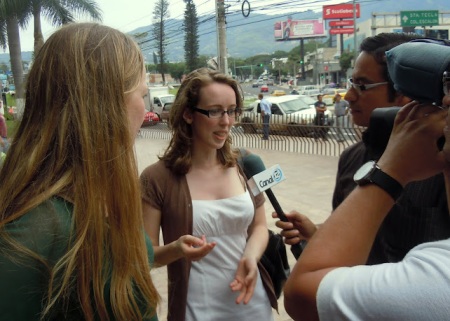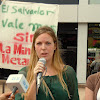Leah and I have finished our research report on public-private partnerships (P3s)! We actually finished last week and celebrated by going to Guatemala for a few days (I'll post on that later).
I've been writing about my activism, misadventures, real adventures, intestinal fauna, and random thoughts, but I've avoided writing about the actual work I've been doing down here. I felt that that telling a gripping story about the process of research is something only Steig Larsen can - or should - do (may he rest in peace). But we found out some really interesting stuff. Right-wing elements in the Salvadoran government, with support from the US government and international financial institutions, are pushing this pro-P3 bill through with all kinds of unusual, and, to my knowledge, unprecedented, features that will harm the country. I'm talking about the special fund that the government has to create for private bidders to borrow from, the provision that forces the government to pay the first bidder 1% of the estimated price of the project if their bid is passed over for one submitted later, the provision that forces the government to pay successful bidders 1% of the project cost if their bid is accepted by the Executive Branch but then rejected by the Legislative Assembly, and the provision that allows 40-year contracts when the international norm is 20-30 year contracts. The thing
about public-private partnerships is that they work really well for 10-15% of capital infrastructure projects, 20% at the most, but no more. The P3 bill would make it mandatory for all levels of government to use P3s for all infrastructure projects and leaves a loophole which could allow P3s to be used for the provision of public services like healthcare, schools, and prisons. P3 service provision is incredibly controversial and has had mixed results.
Anyways, here's the executive summary if you're interested. If you want to read the whole thing, give me a holler. Bear in mind that this is still in draft form and there may be typos and inelegant phrasing.
Governments are responsible for
providing public infrastructure (such as highways, bridges, waste and
wastewater treatment plants, and recreation centres) and public services (such
as education, health care, justice, and corrections). Since the 1980s, and
especially since the 1990s, public-private partnerships (P3s) have become a
popular alternative procurement model for governments who feel they cannot afford
the traditional public procurement process. P3s are particularly prevalent in
the areas of transportation (roads, airports, and railways), utilities
(electricity, water, sewage, gas, telecoms), and amenities (lighting, social
housing, and accommodation). P3s in social services such as prisons, healthcare
and education are emerging, but are significantly more complex and
controversial than their infrastructure counterparts.
P3s are a tool, not a panacea. Their
proponents and detractors agree that P3s are not suitable for the provision of
most public infrastructure and services. For smaller projects (i.e. those
costing under 75 million USD), the P3 model may not be justifiable because any
savings realized in the design and construction phases are outweighed by the
higher procurement and contract management costs (see for e.g. Padova, 2010, p.
3). It is true that P3 procurement can work well in specific contexts – namely
when:
a) projects
have low construction complexity and low revenue uncertainty;
b) risks can
be easily quantified and measured and
effectively transferred to the private sector;
c) the
government has strong contract negotiation and contract management abilities;
d) there is
very little direct customer service as part of the project’s make-up (e.g.,
highways, bridges and other ‘‘dumb’’ infrastructure);
e) the private
sector has extensive experience; and
f) maintenance
of the asset is politically problematic, since the public pressures governments
to spend on other priorities (e.g., salaries and new services) such that the
infrastructure gets run down and becomes more costly than it should be to
operate and maintain across its entire lifespan (list compiled from Vining
& Boardman, 2008, p. 11 and Cohn, 2008, p. 81)
However, in practice such contexts
occur relatively rarely. P3s are not suitable in contexts where accountability
is critical, competition is insufficient, vulnerable populations are affected
or social values are more important than costs (Padova, 2010, p. 12).
Governments experienced with P3
procurement – mainly the United Kingdom and Australia followed by Canada and
some European countries – regard it as one tool among several which can be used
to provide public infrastructure and services. Accordingly, they allocate at most 20% of total government capital
investment in P3 projects (Padova, 2010, p. 12).
Typically the average is 10-15% (see Woodman, 2006; Padova, 2010). Nor do
governments adhere to P3s unquestioningly. The United Kingdom (UK), which
pioneered the widespread use of P3 procurement in the 1980s under the Thatcher
administration, is currently reviewing its commitment to P3s. In November 2011
Her Majesty’s Treasury admitted their concern that P3 contracts are often “too
costly, inflexible, and opaque” and called for evidence on which to base
reforms to its P3-oriented infrastructure provision policy (Her Majesty's Treasury, 2011, p. 3).
As previously mentioned, President Funes’ P3 bill is seen as a
response to the Constraints Analysis published by the government of the United
States (USG) and the Government of El Salvador (GOES) as part of their
bilateral agreement entitled Partnership
for Growth. Through this bill, the government hopes to attract more foreign
direct investment (FDI) to El Salvador so that the economy will grow.
This bill will not achieve its goals because it acts upon a
misdiagnosis. Crime and low tradables productivity are not the reasons that El
Salvador fails to attract FDI. Neighbouring countries with similar economic
profiles and violence rates, such as Honduras, Guatemala and Nicaragua, receive
far more FDI than El Salvador (as shown in Figure 3.) The graph shows that in
2010 – the most recent year for which data is available – El Salvador’s net FDI
went into the red. Foreign investors withdrew 5.56 million USD from the country
while increasing investment in El Salvador’s neighbours.
El Salvador cannot attract FDI because the national economy is not
growing, and a stagnant economy is not attractive to foreign investors. The
economy is not growing for three reasons:
1)
Salaries are low, which depresses purchasing power;
2)
The government has limited cash flow, and;
3)
El Salvador’s population has not grown since 1992 due
to emigration (Villalona, 2012).
By our analysis, the bill has got it backwards. It is trying to
increase FDI to grow the economy, when in reality the economy has to grow
before El Salvador can attract FDI. In its current form, the bill will weaken
Salvadoran sovereignty and drive up the cost of services.
Based on interviews with economists and political experts, and on our
own research, the following would be the ideal and most prudent action to be
taken by Legislative Assembly regarding the P3 Bill so as to increase El
Salvador’s market:
1) The P3 bill
should not be approved by the Legislative Assembly.
2) Instead of focusing
on attracting FDI, the government should focus on decreasing income inequality.
This would increase individual and family purchasing power.
3) Increases
in individual and family purchasing power should be achieved through tax reform
and wealth redistribution. Increases to the minimum wage should be considered.
4) Diversify
El Salvador’s trade partners and forge alliances with key MERCOSUR countries. For
example, Brazil and Argentina would make excellent trading partners, with large
markets and a familiarity with the Latin American economic context.
In the event that the P3 Bill receives approval from the Legislative
Assembly, we make the following recommendations to reduce the harm it will
cause to the population and economy:
1) Remove the requirement in Article 3 that makes P3s
mandatory for state contracting institutions undertaking
infrastructure projects and replace with language that says government parties
should consider using P3s on a case-by-case
basis for 10-15% of infrastructure projects, as appropriate. Alternatively,
make it mandatory for state contracting institutions to consider P3s for infrastructure projects, without imposing a
positive obligation to undertake a P3 should the conditions be deemed
unsuitable.
2) Create a
government body (such as PROESA) to provide procurement and management advice
to levels of government considering entering into a P3. It is crucial that this
regulatory body and all P3 deals should
be subject to strict, transparent oversight by a public interest watchdog.
Require that all employees involved in oversight complete a training program to ensure that they are aware of the
necessary conditions for P3s to be successful.
3) The initial
analysis of the comparative merits of traditional procurement versus a P3
should be measure the total social costs
of the two projects, a more complete indicator than the value for money analysis. If a value for money analysis is used,
the discount rate should be low to reflect the project’s true cost.
4) Stipulate
that contracts cannot exceed twenty
years in length (current concessions are 40 years).
5) Remove the requirement that the government create a
special fund to provide loans to foreign investors.
6) Remove the requirement that the government pay 1% of the
bidding price to unsuccessful bidders. The benefits of any economic incentives
to increase bids are outweighed by the significant unnecessary financial burden
this will place on government finances, particularly for very large, long-term
concessions.
7) Guarantee
that the companies don’t cut jobs
when they take over a public business.
8) Regulate user fees to protect the poor.
9) Explicitly
and permanently prohibit the use of P3s
for service provision in the sectors of health, water provision, social
security, public security (policing, corrections, national defence), and formal education.








































